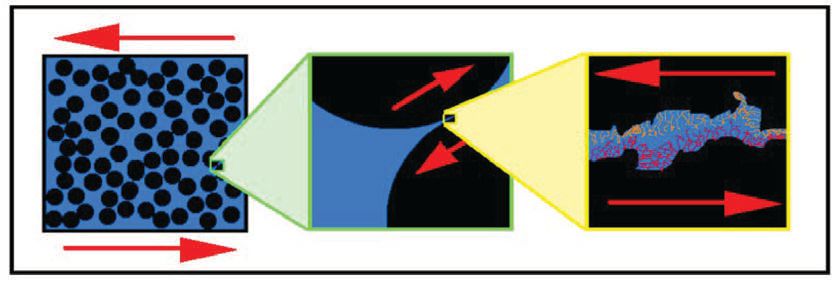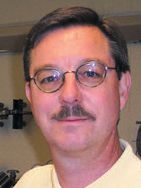Tribology influences rheology influences tribology…
Drs. Wilfred T. Tysoe & Nicholas D. Spencer | TLT Cutting Edge December 2013
A new tribological model to understanding paste rheology fits the experimental facts and points the way to better-flowing cement slurries.

In a dense surry, the grains are so closely spaced that they scrape over each other. Polymer brushes can improve the flow by lubricating the contact regions.
THE FACT THAT THE RHEOLOGICAL PROPERTIES of lubricants have a significant impact on tribological behavior is well known. Tribology influencing rheology is not so obvious, but a just-published paper lies at the heart of a new theory of flow in dense particle suspensions. The research group involved the ETH Zurich, Switzerland, the Ecole Centrale de Lyon, France, and the French cement manufacturer, Lafarge.
Paste rheology is important in many processes, but it is critical in the construction industry where dense cement slurries often need to be pumped long distances into inaccessible places or to significant heights (e.g., to the top of the recently completed Burj Khalifa in Dubai, 829.8 meters). Above a certain particle density, pastes under flow show an increase in viscosity with increasing shear rate. This is known as shear thickening and, at high pumping rates, leads to a much higher energy consumption than would be expected for a simple fluid.
As if this were not bad enough, under certain circumstances the viscosity can increase to infinity. This phenomenon is called discontinuous shear thickening (DST) and can be thought of as a jamming process that completely prevents the paste from flowing. This quickly leads to equipment failure, frustrated builders, hysterical architects and angry investors.
To get to the bottom of this behavior and to try to find a solution to the problem, the Swiss and French researchers looked at flowing cement slurries from a tribological standpoint. The rheological behavior of dense suspensions in a pipe is dominated by interactions between the solid particles in the slurry, which either glide around or scrape over each other, the latter being more likely to happen at higher shear rates. If the particle concentration and shear rate are sufficiently high, this ultimately leads to DST. Thinking in terms of the Stribeck curve, the low-shear-rate behavior can be regarded as hydrodynamic lubrication, while the high-shear-rate behavior is more reminiscent of the boundary regime.
This theory was put to the test both experimentally and with a numerical model. Both showed that lowering the friction coefficient between particles in a slurry allowed flow to occur with higher solids loadings without the dreaded DST occurring. This has important practical consequences, since it means that the cement manufacturer can add small quantities of surface-adsorbing polymers to form a so-called polymer brush on the surface of the particles. These layers significantly reduce particle-particle friction, minimize the likelihood of DST and therefore allow denser cement pastes to be transported through pipes at higher speeds and over longer distances.
It appears that tribological research not only contributes to improving the efficiency of automobile engines and machines, it also has applications in the construction industry.
FOR FURTHER READING
Fernandez, N., Mani, R., Rinaldi, D., Kadau, D., Mosquet, M., Lombois-Burger, H., Cayer-Barrioz, J., Herrmann, H.J., Spencer, N.D., and Isa, L. (2013), “Microscopic Mechanism for the Shear-Thickening of Non-Brownian Suspensions,”
Physical Review Letters,
111 (10), 108301.
 Eddy Tysoe is a Distinguished Professor of Physical Chemistry at the University of Wisconsin-Milwaukee. You can reach him at wtt@uwm.edu
Eddy Tysoe is a Distinguished Professor of Physical Chemistry at the University of Wisconsin-Milwaukee. You can reach him at wtt@uwm.edu.
 Nic Spencer is professor of surface science and technology at the ETH Zurich, Switzerland. Both serve as editors-in-chief of STLE-affiliated Tribology Letters journal. You can reach him at nspencer@ethz.ch
Nic Spencer is professor of surface science and technology at the ETH Zurich, Switzerland. Both serve as editors-in-chief of STLE-affiliated Tribology Letters journal. You can reach him at nspencer@ethz.ch.